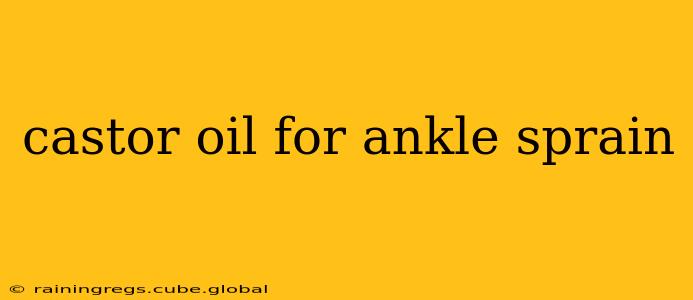Ankle sprains are a common injury, often caused by a sudden twist or turn of the ankle. While conventional treatments like RICE (Rest, Ice, Compression, Elevation) and physical therapy are widely recommended, some individuals explore alternative remedies like castor oil. This comprehensive guide will explore the potential benefits and drawbacks of using castor oil for ankle sprains, addressing common questions and concerns.
Does Castor Oil Help with Ankle Sprains?
The effectiveness of castor oil for ankle sprains is not definitively proven through rigorous scientific research. While anecdotal evidence suggests it may offer some relief from pain and inflammation, it's crucial to understand that it's not a replacement for medical attention. Castor oil's purported benefits stem primarily from its anti-inflammatory and analgesic properties, attributed to ricinoleic acid, its main component. This acid may help reduce swelling and pain, promoting faster healing. However, more research is needed to confirm these effects specifically for ankle sprains.
How to Use Castor Oil for Ankle Sprains?
If you choose to use castor oil, a common application method involves gently warming the oil (never overheat) and applying it directly to the affected area. Massage the oil into the skin around the ankle, ensuring it penetrates well. You can then cover the area with a warm, damp cloth or a bandage to enhance absorption. It's generally recommended to repeat this process several times a day. Always conduct a patch test on a small area of skin before applying it liberally to check for any allergic reactions.
Can Castor Oil Reduce Swelling from an Ankle Sprain?
Ricinoleic acid in castor oil possesses anti-inflammatory properties that may help reduce swelling associated with an ankle sprain. However, it's crucial to remember that it's not a guaranteed solution and shouldn't be relied upon as the sole treatment. Combining castor oil application with proper RICE methods is often suggested, but scientific evidence supporting this combination's superior effectiveness over RICE alone is limited. Significant swelling warrants immediate medical attention.
Is Castor Oil Good for Ankle Pain Relief?
Castor oil's analgesic properties, also linked to ricinoleic acid, may offer some pain relief. However, the level of pain relief varies from person to person, and it's unlikely to provide significant relief for severe pain. For substantial pain management, consulting a doctor for appropriate pain medication is essential. Consider castor oil as a supplementary approach, not a primary solution for pain relief.
What are the Side Effects of Using Castor Oil on an Ankle Sprain?
While generally considered safe for topical application, some individuals may experience mild side effects such as skin irritation, redness, or allergic reactions. A patch test is always recommended before widespread application. Severe allergic reactions are rare but possible. If you experience any concerning side effects, discontinue use immediately and consult a medical professional.
When Should I See a Doctor for an Ankle Sprain?
Regardless of whether you're using castor oil or not, it's crucial to seek professional medical advice for ankle sprains, especially if:
- You experience severe pain.
- You have significant swelling or bruising.
- You can't bear weight on your ankle.
- You hear a popping sound during the injury.
- The pain persists for more than a few days.
- You notice numbness or tingling in your foot.
A doctor can properly diagnose the severity of your sprain and recommend the most appropriate treatment plan, which may involve physical therapy, immobilization, or other medical interventions.
Disclaimer: This information is for educational purposes only and should not be considered medical advice. Always consult with a qualified healthcare professional before starting any new treatment for an ankle sprain or any other medical condition.
